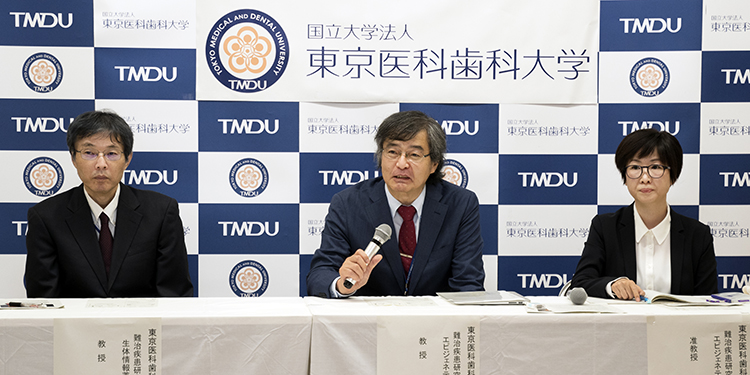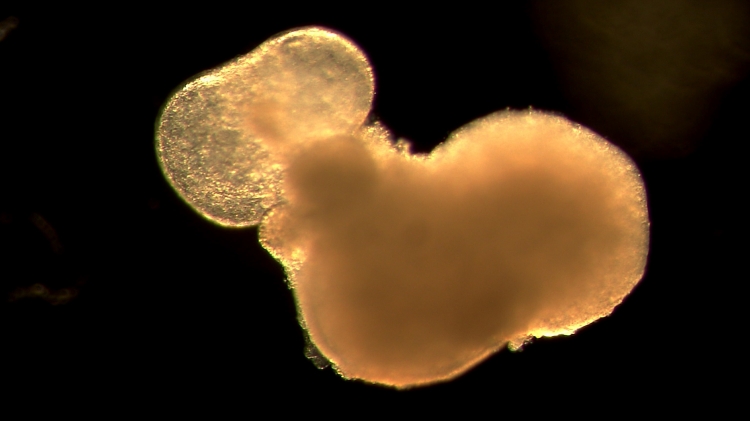Generation of three-dimensional heart organoids

Researchers from Tokyo Medical and Dental University (TMDU) use mouse embryonic stem cells to engineer three-dimensional functional heart organoids resembling the developing heart
Heart organoid generated from mouse ES cells

This heart organoid has atria- and ventricle-like structures and also exhibits beating movement.
Tokyo, Japan –Heart development as it happens in vivo, or in a living organism, is a complex process that has traditionally been difficult to mimic in vitro, or in the laboratory. In a new study, researchers from Tokyo Medical and Dental University (TMDU) developed three-dimensional functional heart organoids from mouse embryonic stem cells that closely resemble the developing heart.
The heart consists of multiple layers of tissue including many different cell types, including working heart muscle, connective tissue cells, and cells that make up blood vessels. These cells work together to ensure a proper functioning of the heart and thus the constant supply of fresh, oxygenated blood to the rest of the body. Studying all forms of heart disease in the laboratory and developing novel drugs to treat these diseases require disease models that closely resemble the actual heart. While effort has been made to generate heart muscle cells in vitro, these cells present as clumps without the tissue organization seen in vivo.
“Despite its seemingly simple function, the heart is a complex organ with an even more complex structure,” say corresponding authors of the study Professors Jiyoung Lee and Fumitoshi Ishino. “To achieve that level of structural complexity, during development the heart is exposed to a myriad of signals. We wanted to capitalize on our knowledge of the signaling molecules during heart development and generate heart organoids that resemble the developing heart more closely than current techniques.”
To achieve their goal, the researchers looked into the factors involved in heart development in vivo and speculated that the protein fibroblast growth factor 4 (FGF4) and a complex consisting of the proteins laminin and entactin (LN/ET complex), all of which are known are expressed in the embryonic heart, are necessary and sufficient to enable structural similarity between the heart organoids and the actual embryonic heart. Indeed, mouse embryonic stem cells exposed to FGF4 and LN/ET showed considerable similarity to the developing heart based on structural as well as molecular analyses.
Intriguingly, the process of development in the heart organoids closely reflected the morphological changes during embryonic heart development in vivo. A closer look at the cellular components making up the heart organoids revealed that cells of the embryonic heart, including cells of all four chambers as well as of the conduction system, were present in the structural organization seen during embryonic development. Importantly, the heart organoids possessed functional properties close to their in vivo-counterpart.
“These are striking results that show how our method provides a biomimetic model of the developing heart using a rather simple protocol. This tool could be helpful in studying the molecular processes during heart development, and in developing and testing novel drugs against heart disease,” say Professors Lee and Ishino.
###
The article, “In vitro generation of functional murine heart organoids via FGF4 and extracellular matrix,” was published in Nature Communications at DOI: 10.1038/s41467-020-18031-5
The heart consists of multiple layers of tissue including many different cell types, including working heart muscle, connective tissue cells, and cells that make up blood vessels. These cells work together to ensure a proper functioning of the heart and thus the constant supply of fresh, oxygenated blood to the rest of the body. Studying all forms of heart disease in the laboratory and developing novel drugs to treat these diseases require disease models that closely resemble the actual heart. While effort has been made to generate heart muscle cells in vitro, these cells present as clumps without the tissue organization seen in vivo.
“Despite its seemingly simple function, the heart is a complex organ with an even more complex structure,” say corresponding authors of the study Professors Jiyoung Lee and Fumitoshi Ishino. “To achieve that level of structural complexity, during development the heart is exposed to a myriad of signals. We wanted to capitalize on our knowledge of the signaling molecules during heart development and generate heart organoids that resemble the developing heart more closely than current techniques.”
To achieve their goal, the researchers looked into the factors involved in heart development in vivo and speculated that the protein fibroblast growth factor 4 (FGF4) and a complex consisting of the proteins laminin and entactin (LN/ET complex), all of which are known are expressed in the embryonic heart, are necessary and sufficient to enable structural similarity between the heart organoids and the actual embryonic heart. Indeed, mouse embryonic stem cells exposed to FGF4 and LN/ET showed considerable similarity to the developing heart based on structural as well as molecular analyses.
Intriguingly, the process of development in the heart organoids closely reflected the morphological changes during embryonic heart development in vivo. A closer look at the cellular components making up the heart organoids revealed that cells of the embryonic heart, including cells of all four chambers as well as of the conduction system, were present in the structural organization seen during embryonic development. Importantly, the heart organoids possessed functional properties close to their in vivo-counterpart.
“These are striking results that show how our method provides a biomimetic model of the developing heart using a rather simple protocol. This tool could be helpful in studying the molecular processes during heart development, and in developing and testing novel drugs against heart disease,” say Professors Lee and Ishino.
###
The article, “In vitro generation of functional murine heart organoids via FGF4 and extracellular matrix,” was published in Nature Communications at DOI: 10.1038/s41467-020-18031-5
Summary
Researchers from Tokyo Medical and Dental University (TMDU) engineered three-dimensional functional heart organoids resembling the developing heart. By exposing mouse embryonic stem cells to two key proteins during heart development, the researchers were able to form heart organoids with structural, functional, and molecular similarities to the embryonic heart during development. This method could be used to study heart development and to screen for novel drugs against heart disease.
Correspondence to
Fumitoshi ISHINO , Professor
E-mail: fishino.epgn(at)mri.tmd.ac.jp
Jiyoung Lee , Associate Professor
E-mail: jlee.epgn(at)mri.tmd.ac.jp
Department of Epigenetics
Medical Research Institute
Tokyo Medical and Dental University(TMDU)
*Please change (at) in e-mail addresses to @ on sending your e-mail to contact personnels.
E-mail: fishino.epgn(at)mri.tmd.ac.jp
Jiyoung Lee , Associate Professor
E-mail: jlee.epgn(at)mri.tmd.ac.jp
Department of Epigenetics
Medical Research Institute
Tokyo Medical and Dental University(TMDU)
*Please change (at) in e-mail addresses to @ on sending your e-mail to contact personnels.

